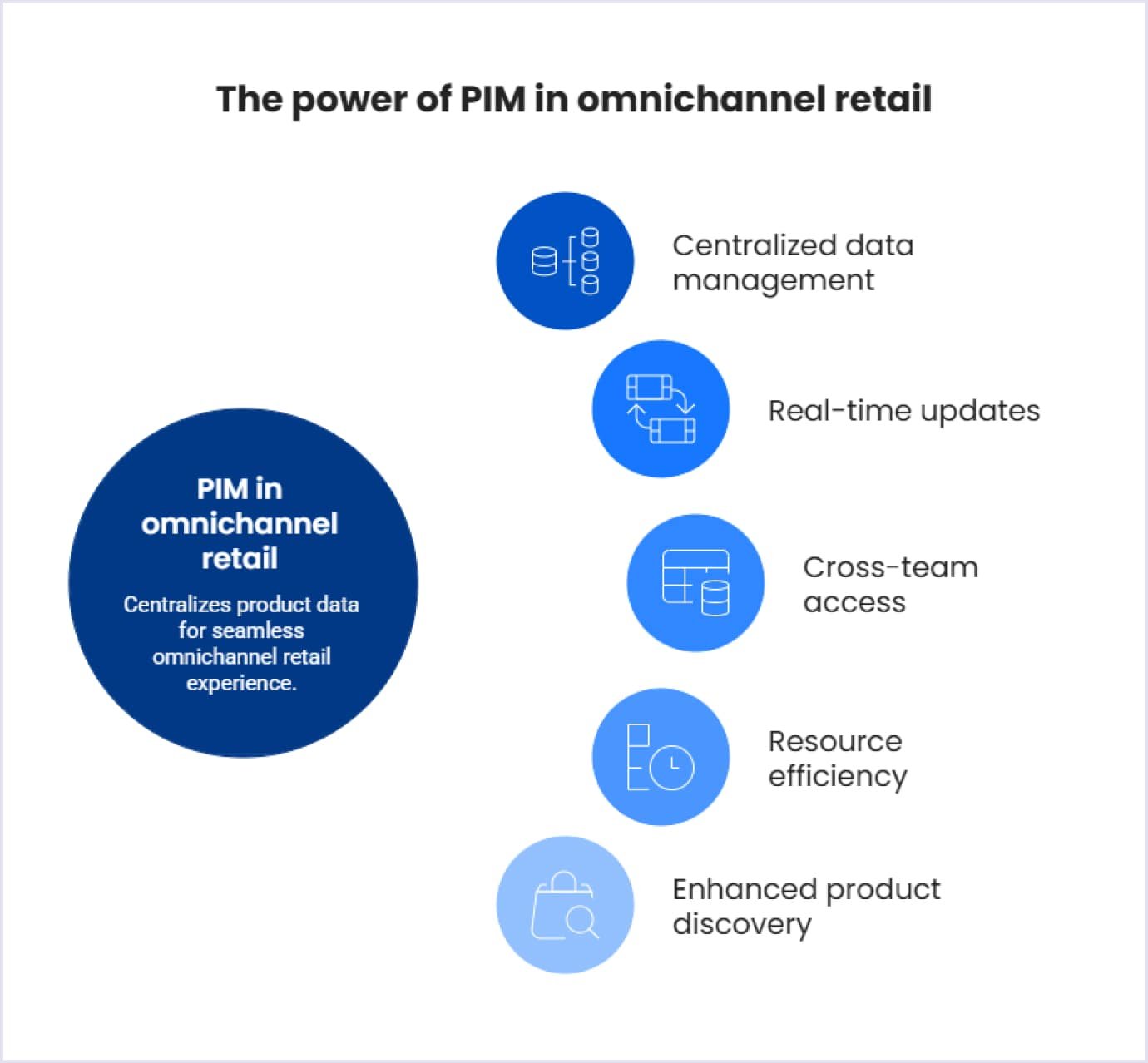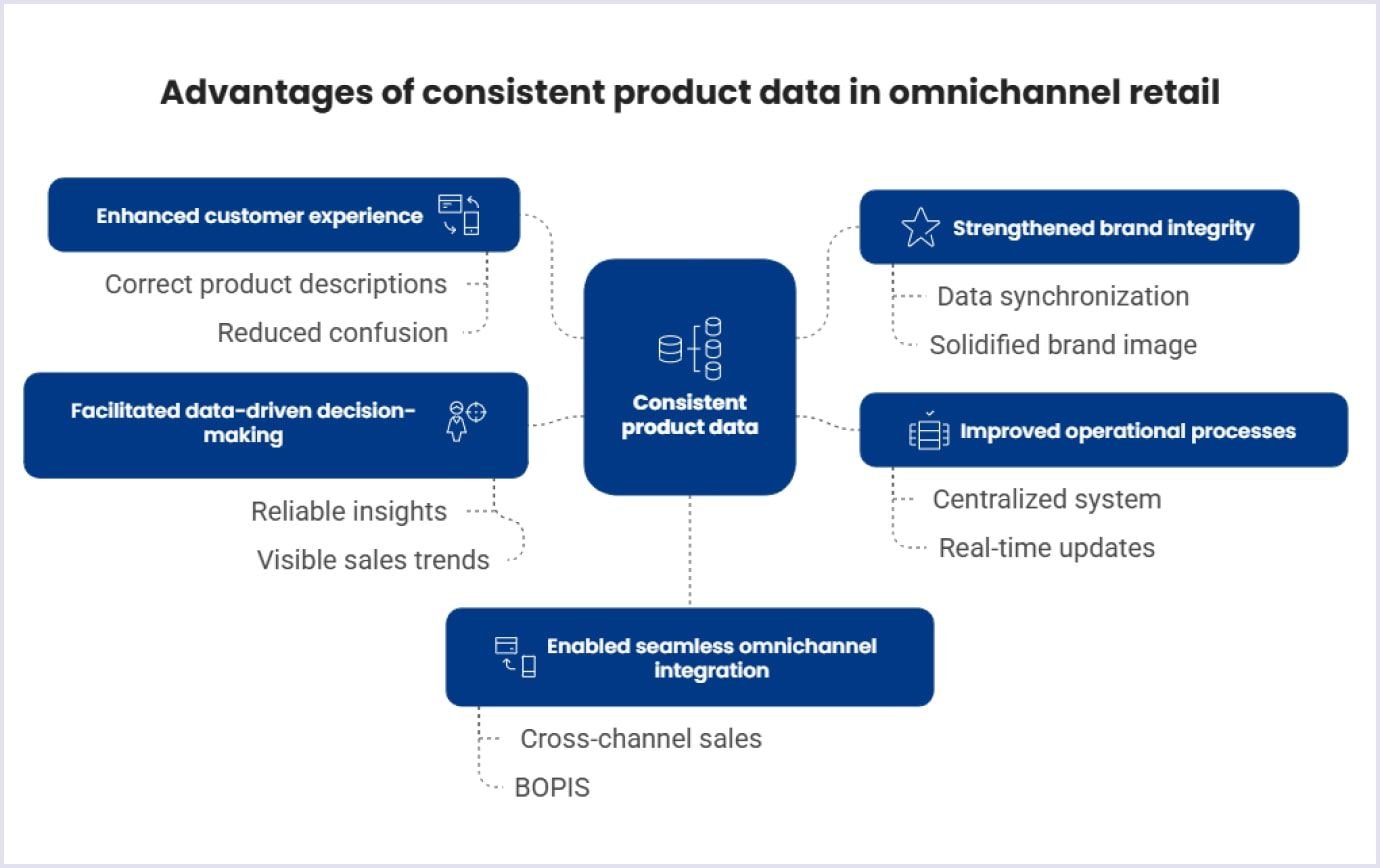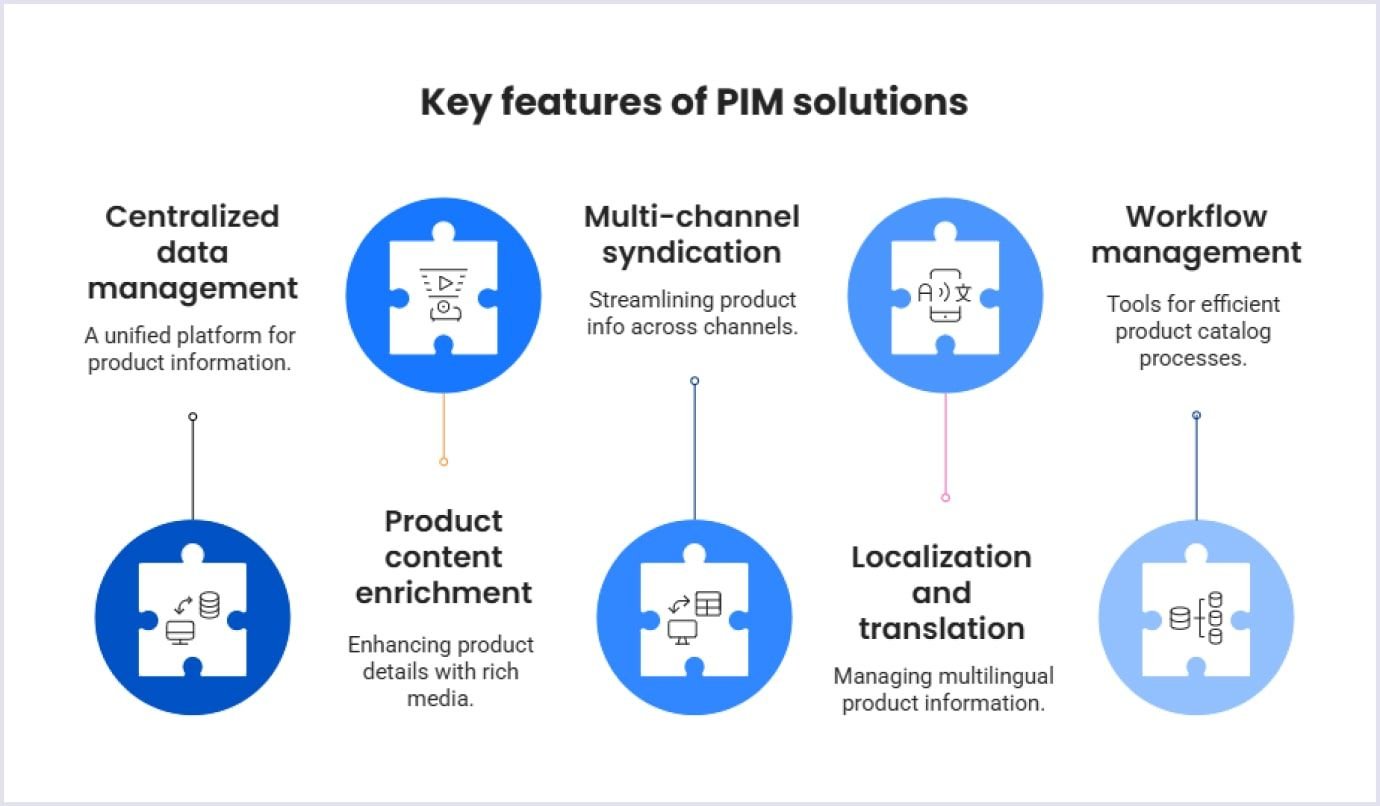Product information management helps you organize your product details with a centralized system. Diverse product data is gathered in a unified software system that passes updates to all sales channels as soon as a team makes them.
This efficiency in product data syndication is invaluable for omnichannel retail sales, especially if they expand globally. According to Syndigo’s survey, 83% of customers would abandon an ecommerce platform if product details are inadequate. PIM prevents this by delivering instant updates across all your customer touchpoints, wherever they reach.
In this post, we discuss what a PIM system is and why it is a game-changer for retailers with omnichannel sales. Our team explores its benefits for multichannel retail consistency and vital aspects to implement it.
Omnichannel sales and Product Information Management (PIM)
Before discussing the PIM, let’s briefly cover what omnichannel retail is to understand the subject clearly. Omnichannel retail means that a vendor uses their physical store and digital platforms to sell their products. Thus, customers have a smooth transition from a showroom to a website or ecommerce marketplace platform and vice versa.
In this regard, product information management is a crucial step to facilitate the journey between your sales channels and your customers. You have products with different parameters, like in fashion, engineering, medicine, and other industries. These parameters are essential for your buyers, and they are one of the ways your customers discover your products.
PIM is a system that centralizes data, and it became part of sales in the late 1990s and early 2000s. It has been evolving ever since and has enhanced product data automation. As a single solution, PIM brings together all your product information in one system. It gives you instant updates across your channels and cross-team access to the most recent product data in real time. The PIM system saves tons of time, effort, and resources in sales, thanks to its centralized nature, while preserving rich product content.

How consistent product data strengthens omnichannel retail business
Traditionally, teams working with the same product content needed to deal with many documents and exchange emails when updates were necessary. This method was time-consuming and led to errors and misunderstandings.
Consistency is essential for product information management in different aspects. Here are the major advantages of product data consistency in an omnichannel retail strategy:
- Enhanced customer experience. As customers shop via different channels, consistent product descriptions are essential for delightful buyer experiences. When product details are correct, it reduces confusion and builds trust.
- Strengthened brand integrity. Discrepancies in product information make a company look careless. Retail data synchronization allows for consistency, which solidifies brand image.
- Improved operational processes. With the centralized system, your teams make updates and access them as they appear. No need to back-and-forth documents and data.
- Facilitated data-driven decision-making. Consistent data is a reliable source of insights, such as how products perform and what customers prefer. Thus, retailers can anticipate and respond to sales trends.
- Enabled seamless omnichannel integration. Product data is synchronized across all platforms, enabling cross-channel sales, such as "buy online, pick up in-store" (BOPIS).

Challenges of managing product data across diverse sales channels
An omnichannel store operations involve multiple teams. Sellers, product management, merchandising, marketing, and other teams handle product information for thousands of products with different details. Imagine how overwhelming those tasks become without streamlining. The manual product information management processes come with the following difficulties:
- Data silos and integration issues. Often, data is stored in separate departments with restricted access. If only a specific specialist or team has access to the data, this leads to data silos.
- Maintaining data consistency and accuracy. When updates are made frequently and access is given to certain parties, uniform and accurate product information becomes a challenge.
- Real-time data synchronization. In omnichannel retail, product data must be updated in real time. It helps reflect changes in inventory, pricing, and promotions. Delayed updates can lead to issues like stock excess or shortage.
- Compliance with data privacy and security regulations. As stores process sensitive information, scattered product data management makes it difficult to adhere to data privacy and security standards.
- Resource intensiveness. Unlike with single-source system management, separate channels need unique software. Implementing software for each channel takes time and needs professional care.

How PIM enhances omnichannel retail strategies
A PIM system gathers and organizes data scattered between different channels and teams. Thanks to its centralizing functionality, PIM helps you take your omnichannel retail operations under control. When implementing this management system, you gain the following improvements in your sales operations and omnichannel customer experience:
- Centralized product data management. This is the core benefit of PIM and a basis for other advantages. Consolidating data from various sources ensures that updates appear across all channels at once. Moreover, the unified platform gives access to data for all stakeholders eliminating data silos and streamlining product data onboarding.
- Consistent customer experience across channels. As Salesforce’s survey shows, 78% of consumers use different channels to start and finish a transaction. These results underline the importance of consistency across different channels to improve customer experience.
- Accelerated time-to-market. With centralization, product information management systems enable retailers to introduce new products and update existing ones more swiftly. Thus, businesses respond promptly to market trends and consumer demands.
- Enhanced data accuracy and reduced errors. PIM automates product taxonomy management processes and minimizes the need to enter information manually. Thus, product listings are more accurate, and customers get the correct details about the product they want.
- Improved operational efficiency. PIM acts as a single source of truth. Hence, your teams, third-party contractors, and other stakeholders enter and get updates as soon as they appear across channels and regions.
- Personalization and localization. Thanks to PIM, retailers can personalize their listings to different contexts, such as languages, cultures, and regions. As stats show, customers spend 34% more when their experience is personalized. Thus, channel-specific product content will win your customers’ satisfaction.

Key features to look for in a PIM solution
Today’s market of PIM solutions is diverse. So, it is necessary to understand your business goals before choosing one. Depending on your objectives, you can select the right PIM platform that will help you optimize specific processes in your store.
As an online marketplace development company, we’ve seen how PIM helps businesses in operations. Thus, we outline several typical features below that make it a handy tool in omnichannel retail:

- Centralized data management. PIM systems offer a single platform to collect, manage, and enrich product information. These processes ensure that customers, teams, and stakeholders access the same precise data.
- Product content enrichment. Beyond basic product details, you can add rich content with PIM. This includes images, videos, and marketing descriptions. Data enrichment enhances your customers' overall product experience and helps improve your digital shelf optimization (DOS).
- Multi-channel product information syndication. PIM streamlines product information across retail sales and marketing channels. It preserves data consistency and accuracy and reduces the risk of errors, improving product experience management.
- Localization and translation. For businesses operating in multiple regions, PIM supports the management of multilingual data. Thanks to the platform, you can adapt product information to local languages and cultural nuances.
- Workflow management. PIM systems often include tools to streamline workflows in ecommerce product catalog management. They enable teams to align their workflows on product data management tasks.

Case studies: successful PIM implementations in omnichannel retail
PIM systems help brands solve their business challenges and ensure their growth. The following are prominent successful cases that show how PIM platforms solve real-life problems and help businesses evolve.
Shree
It is a women’s ethnic wear brand that provides casual and elegant products. The company had software to manage their operations. However, it did not meet the brand’s growing business needs, which included integration for their points of sale (POS) and ERP systems.
In this regard, the Ginesys PIM system helped them merge their POS and ERP software and also provided a suite of ecommerce integrations. With Ginesys, Shree grew from 30 stores to 100+ exclusive brand outlets (EBOs) and 3000+ retail points.

Source: Shree
Adorama
This legendary retailer, established in 1974, sells cameras, electronics, and film equipment. They deal in high-end, delicate, and technically complex products. It’s essential to keep the data accurate at scale in this industry.
Adorama’s aging software could not keep up with the company’s needs in product information management. Hence, the retailer turned to Syndigo and introduced their Enhanced Content and PIMpoint Precision features. This implementation brought the company the following wins:
- Add-to-cart growth of 27%;
- Flexibility in putting products to market;
- Improved management of complex technology and partnership needs.

Source: Adorama
Best practices for implementing PIM in your retail business
Including a PIM system is a strategic process that involves a clear understanding of your business needs. Below, our experts outline the best practices to maximize ROI with a PIM system in your retail business:
- Define clear objectives and scope. Understand the challenges you want to solve with PIM. These include improving data accuracy, accelerating time-to-market, or enhancing customer experiences. This product discovery stage is crucial to get your PIM development and integration right from the start.
- Establish robust product data governance. This means setting the uniform system of product information standards, data entry, and defining roles and permissions. Then, implement validation steps to ensure accuracy across channels and marketplace listing optimization.
- Ensure integration flexibility. Ensure that your PIM will integrate with your current systems, such as ecommerce integrations, ERP, and CRM. Proper integration ensures a trouble-free product information workflow in your operations.
- Standardize product data. Establish uniform standards for product attributes, categories, and naming conventions. This consistency across all sales channels will simplify data management and improve data quality metrics and customer experience.
- Implement automated data enrichment. Images, videos, descriptions, and specifications should be added automatically in PIM for accuracy and consistency.
- Prioritize scalability. Select a PIM solution with a scalable architecture that can grow with your business without diminishing performance.

To conclude
Handling complex product information and sales processes in omnichannel retail can require much effort and be error-prone. That is why a PIM solution is a force multiplier when retail businesses use various sales channels and expand globally. Not only does the system streamline data updates, but it also reinforces trust in your brand by bringing top-notch personalized experiences to your customers.
If you need an integration of a PIM solution to streamline your ecommerce platform and operations, our team is eager to help. As presented in our portfolio, we have over 10 years of experience in custom software development for successful businesses. Contact us, and our experts will help you with the details and give you a free quote.
